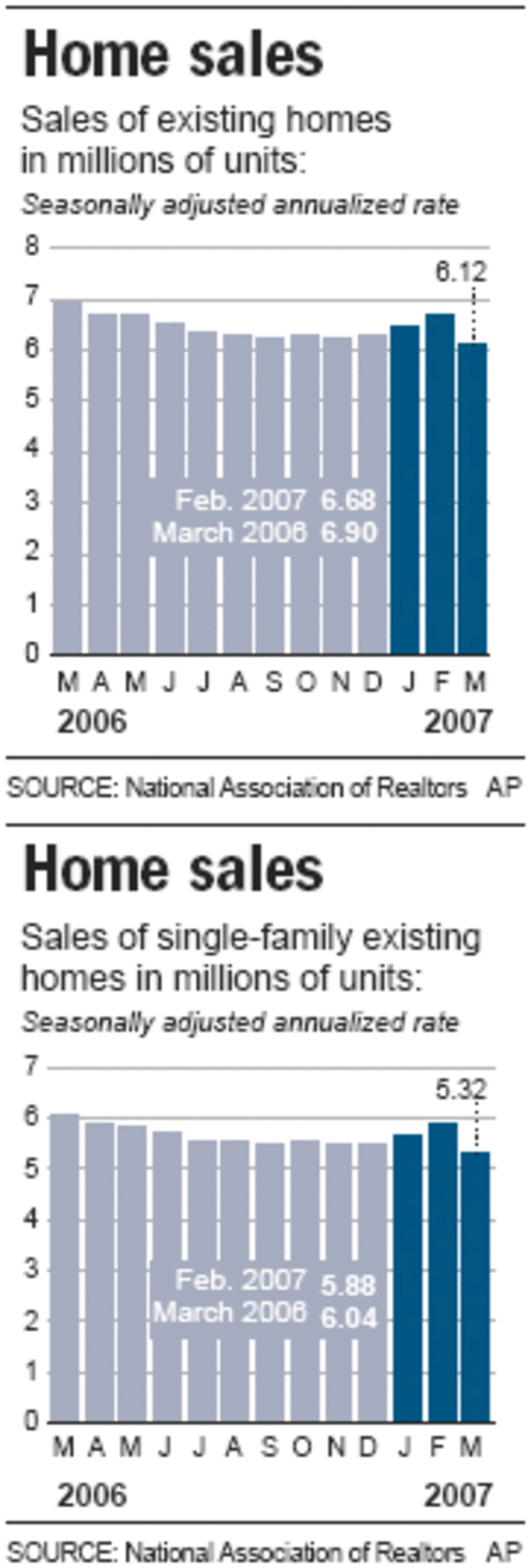Sales of existing homes plunged in March by the largest amount in 18 years, reflecting in part rising troubles in the subprime mortgage market.
Analysts cautioned that tougher approval standards by lenders in response to the increase in mortgage delinquencies will depress sales further in coming months. They said a rebound in housing may not occur until 2008.
The National Association of Realtors reported Tuesday that sales of existing homes fell by 8.4 percent in March, the sharpest drop since a 12.6 percent plunge in January 1989.
The decline, which was three-times what had been expected, pushed sales down to a seasonally adjusted annual rate of 6.12 million units, the slowest pace in nearly three years.
The drop, which followed three straight months when sales had risen, was blamed in part on bad weather in February which depressed house hunting in much of the country after a string of warmer-than-normal months had pushed sales higher.
Existing home sales are not counted until the deal is closed though contracts signed in February do not get counted until March.
But analysts said the severity of the decline showed that factors other than weather played a part.

They said troubles in the subprime mortgage market, which supplied loans to borrowers with weak credit, was starting to have an impact on sales. Potential buyers are having more trouble getting loans as lenders tighten standards.
In addition, because of a rising number of mortgage delinquencies more homes are being dumped onto an already glutted market. RealtyTrac, which follows mortgage foreclosures, reported that foreclosures surged by 47 percent in March compared to a year ago.
The Realtors’ report said that with sales falling, the amount of time it would take to exhaust the existing inventory of unsold homes at the March sales pace rose to 7.3 months, 30 percent longer than a year ago.
The glut of unsold homes depressed prices further with the median home price dropping for a record eighth straight month to $217,000 in March, down 0.3 percent from the median sales price a year ago. The median is the point where half the homes sold for more and half for less.
A separate report on home prices released Tuesday by Standard & Poor’s found that prices dropped 1.5 percent in February, compared to a year ago. That was the steepest decline in nearly 15 years, according to the S&P/Case-Shiller composite index of home sales in 10 metropolitan markets.
“The number of homeowners trying to unload their properties is still so ridiculously high that pressures on prices will likely continue,” said Joel Naroff, chief economist at Naroff Economic Advisors. “How much lower the housing market can go is unclear, but it is not likely that we have seen the bottom.”
Sen. Charles Schumer, chairman of Congress’ Joint Economic Committee, said that the weakness in existing home sales underscored the need for action to help borrowers at risk of losing their homes.
“With a brewing storm of subprime mortgage foreclosures on the horizon, the quickest way to instill more confidence in the overall housing market is to curb the wave of foreclosures,” Schumer, D-N.Y., said in a statement.
David Lereah, chief economist for the Realtors, said he didn’t expect a full recovery in housing until 2008. He predicted that sales of existing homes would drop by about 3 percent this year with the decline in sales of new homes an even steeper 15 percent.
“The negative impact of subprime is considerable,’ he said.
He said that the median price for homes sold in 2007 would fall by 1 percent to 3 percent, which would be the first price decline for an entire year on the Realtors’ records, which go back four decades.
There was weakness in every part of the country in March. Sales fell by 10.9 percent in the Midwest. They were down 9.1 percent in the West, 8.2 percent in the Northeast and 6.2 percent in the South.
The steep slump in housing over the past year has been a major factor slowing the overall economy. It has subtracted around 1 percentage point from growth since mid-2006.
Many analysts believe the serious slump in housing is the result of a speculative bubble bursting after home sales set records for five straight years. The boom years triggered a rush of investors into the market who pushed demand higher by buying second homes in hopes of reselling them for quick profits.
Wall Street had earlier hoped that the weakness in housing might convince the Federal Reserve to start cutting interest rates, but Fed officials continue to signal that their greater worry remains that the slowing economy will not bring inflation pressures down quickly enough.